Analyzing Factors Influencing Corporate Profitability
VerifiedAdded on 2020/06/04
|56
|16050
|44
AI Summary
The task aims at understanding how multiple internal and external factors contribute to corporate profitability. By examining the provided references and conducting a correlation analysis on relevant datasets, students will identify key drivers of profitability such as financial ratios, market conditions, operational efficiencies, and strategic decisions. The study also involves reviewing additional online resources to gather further insights into contemporary business practices affecting profit levels. This exploration seeks to deepen knowledge in financial performance analysis by linking theoretical concepts with practical examples from current industry data.
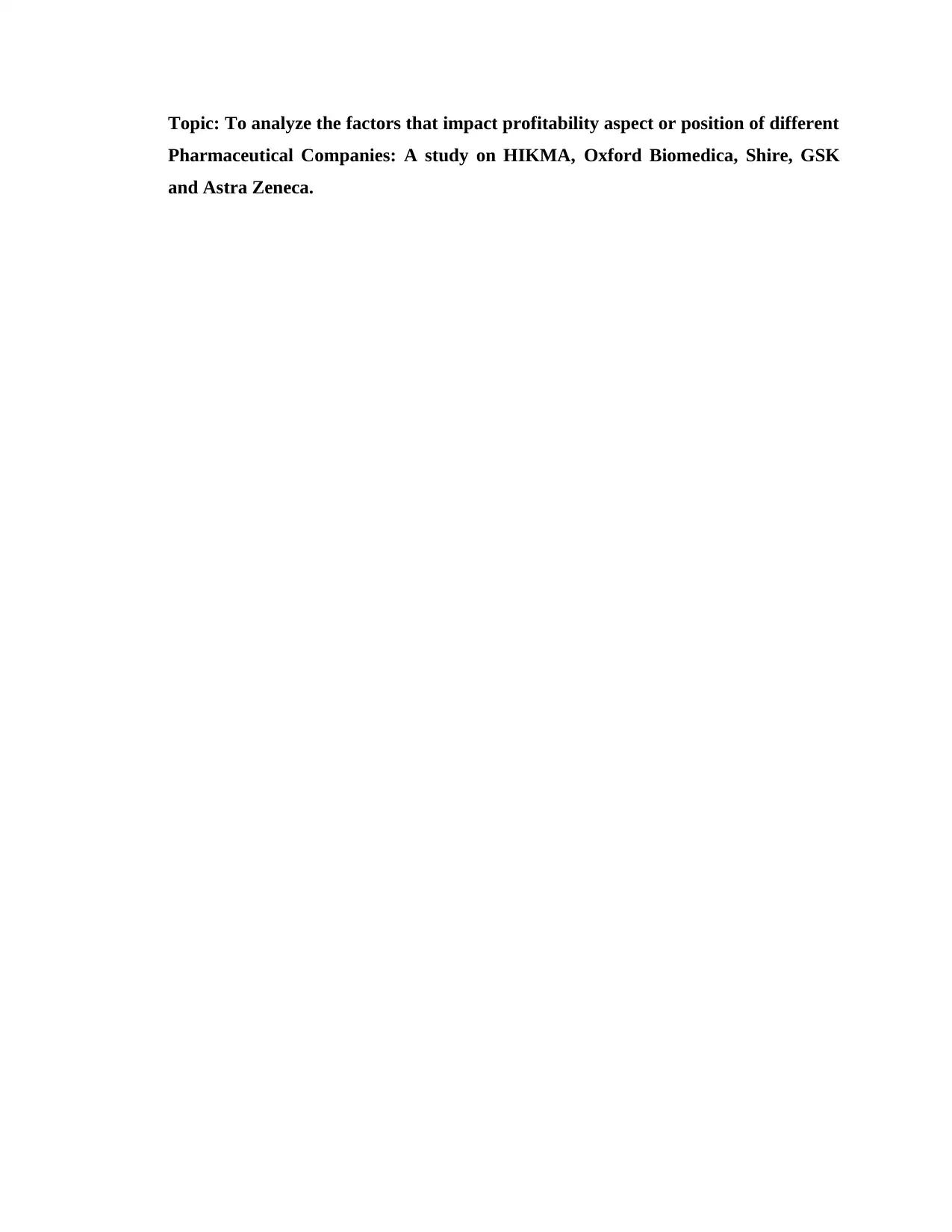
Topic: To analyze the factors that impact profitability aspect or position of different
Pharmaceutical Companies: A study on HIKMA, Oxford Biomedica, Shire, GSK
and Astra Zeneca.
Pharmaceutical Companies: A study on HIKMA, Oxford Biomedica, Shire, GSK
and Astra Zeneca.
Paraphrase This Document
Need a fresh take? Get an instant paraphrase of this document with our AI Paraphraser
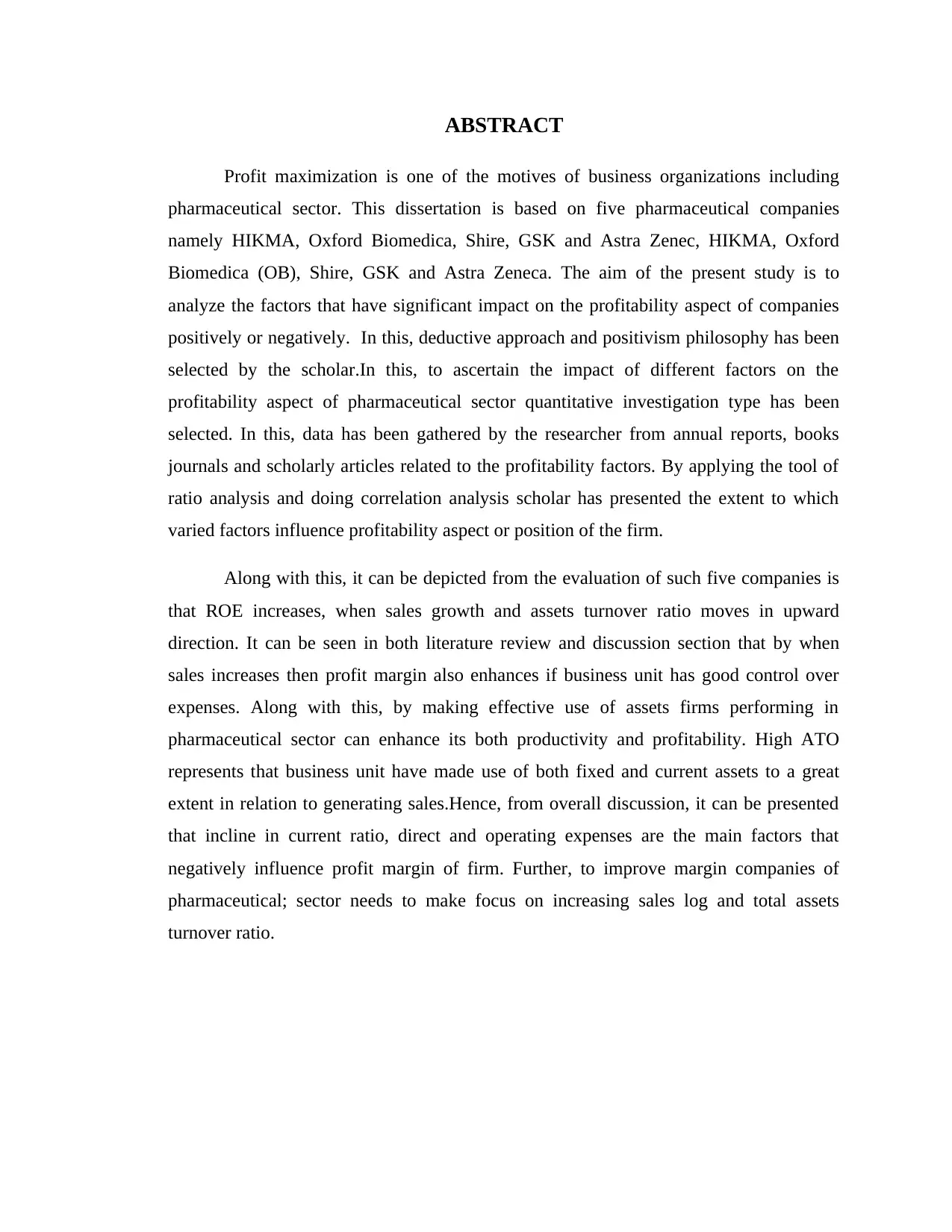
ABSTRACT
Profit maximization is one of the motives of business organizations including
pharmaceutical sector. This dissertation is based on five pharmaceutical companies
namely HIKMA, Oxford Biomedica, Shire, GSK and Astra Zenec, HIKMA, Oxford
Biomedica (OB), Shire, GSK and Astra Zeneca. The aim of the present study is to
analyze the factors that have significant impact on the profitability aspect of companies
positively or negatively. In this, deductive approach and positivism philosophy has been
selected by the scholar.In this, to ascertain the impact of different factors on the
profitability aspect of pharmaceutical sector quantitative investigation type has been
selected. In this, data has been gathered by the researcher from annual reports, books
journals and scholarly articles related to the profitability factors. By applying the tool of
ratio analysis and doing correlation analysis scholar has presented the extent to which
varied factors influence profitability aspect or position of the firm.
Along with this, it can be depicted from the evaluation of such five companies is
that ROE increases, when sales growth and assets turnover ratio moves in upward
direction. It can be seen in both literature review and discussion section that by when
sales increases then profit margin also enhances if business unit has good control over
expenses. Along with this, by making effective use of assets firms performing in
pharmaceutical sector can enhance its both productivity and profitability. High ATO
represents that business unit have made use of both fixed and current assets to a great
extent in relation to generating sales.Hence, from overall discussion, it can be presented
that incline in current ratio, direct and operating expenses are the main factors that
negatively influence profit margin of firm. Further, to improve margin companies of
pharmaceutical; sector needs to make focus on increasing sales log and total assets
turnover ratio.
Profit maximization is one of the motives of business organizations including
pharmaceutical sector. This dissertation is based on five pharmaceutical companies
namely HIKMA, Oxford Biomedica, Shire, GSK and Astra Zenec, HIKMA, Oxford
Biomedica (OB), Shire, GSK and Astra Zeneca. The aim of the present study is to
analyze the factors that have significant impact on the profitability aspect of companies
positively or negatively. In this, deductive approach and positivism philosophy has been
selected by the scholar.In this, to ascertain the impact of different factors on the
profitability aspect of pharmaceutical sector quantitative investigation type has been
selected. In this, data has been gathered by the researcher from annual reports, books
journals and scholarly articles related to the profitability factors. By applying the tool of
ratio analysis and doing correlation analysis scholar has presented the extent to which
varied factors influence profitability aspect or position of the firm.
Along with this, it can be depicted from the evaluation of such five companies is
that ROE increases, when sales growth and assets turnover ratio moves in upward
direction. It can be seen in both literature review and discussion section that by when
sales increases then profit margin also enhances if business unit has good control over
expenses. Along with this, by making effective use of assets firms performing in
pharmaceutical sector can enhance its both productivity and profitability. High ATO
represents that business unit have made use of both fixed and current assets to a great
extent in relation to generating sales.Hence, from overall discussion, it can be presented
that incline in current ratio, direct and operating expenses are the main factors that
negatively influence profit margin of firm. Further, to improve margin companies of
pharmaceutical; sector needs to make focus on increasing sales log and total assets
turnover ratio.
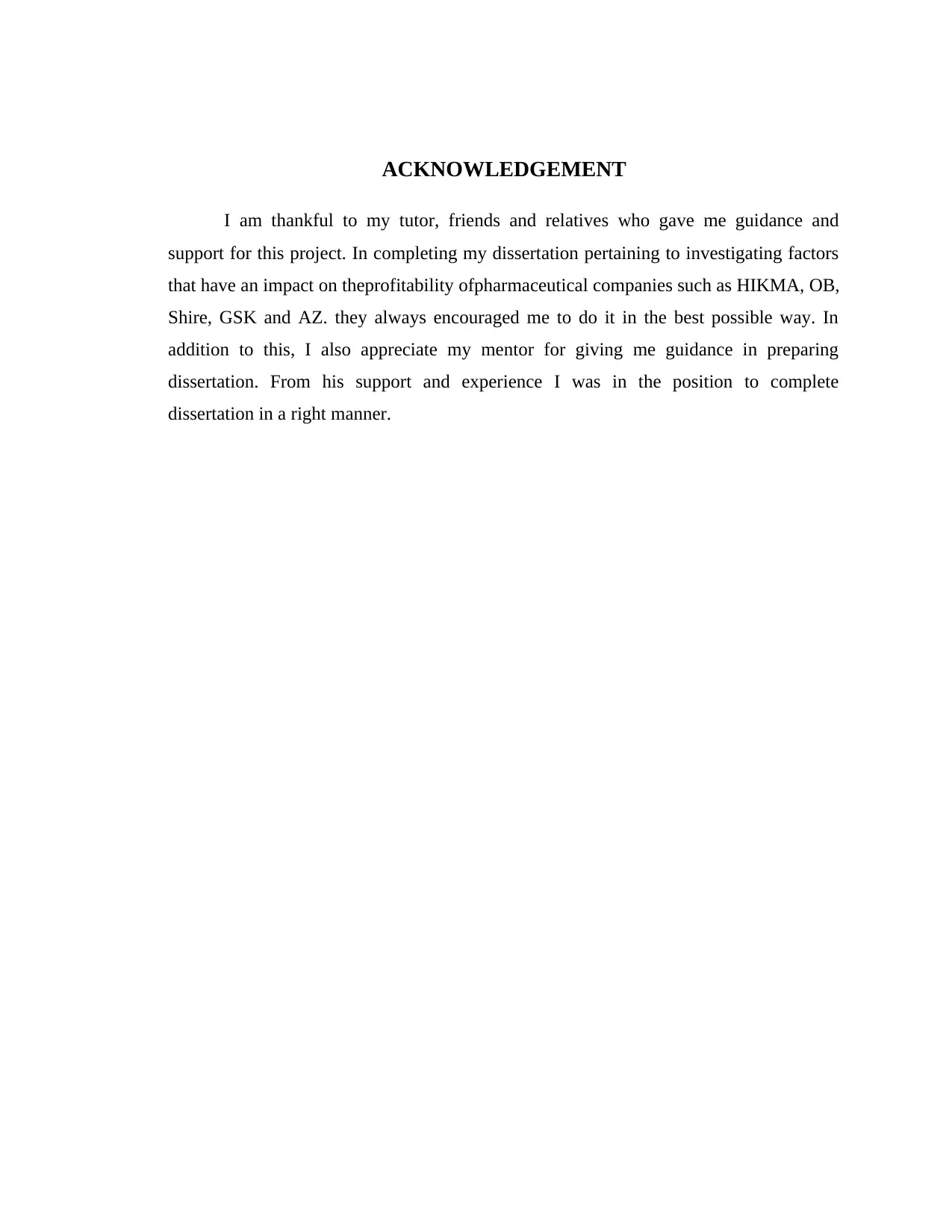
ACKNOWLEDGEMENT
I am thankful to my tutor, friends and relatives who gave me guidance and
support for this project. In completing my dissertation pertaining to investigating factors
that have an impact on theprofitability ofpharmaceutical companies such as HIKMA, OB,
Shire, GSK and AZ. they always encouraged me to do it in the best possible way. In
addition to this, I also appreciate my mentor for giving me guidance in preparing
dissertation. From his support and experience I was in the position to complete
dissertation in a right manner.
I am thankful to my tutor, friends and relatives who gave me guidance and
support for this project. In completing my dissertation pertaining to investigating factors
that have an impact on theprofitability ofpharmaceutical companies such as HIKMA, OB,
Shire, GSK and AZ. they always encouraged me to do it in the best possible way. In
addition to this, I also appreciate my mentor for giving me guidance in preparing
dissertation. From his support and experience I was in the position to complete
dissertation in a right manner.
⊘ This is a preview!⊘
Do you want full access?
Subscribe today to unlock all pages.

Trusted by 1+ million students worldwide
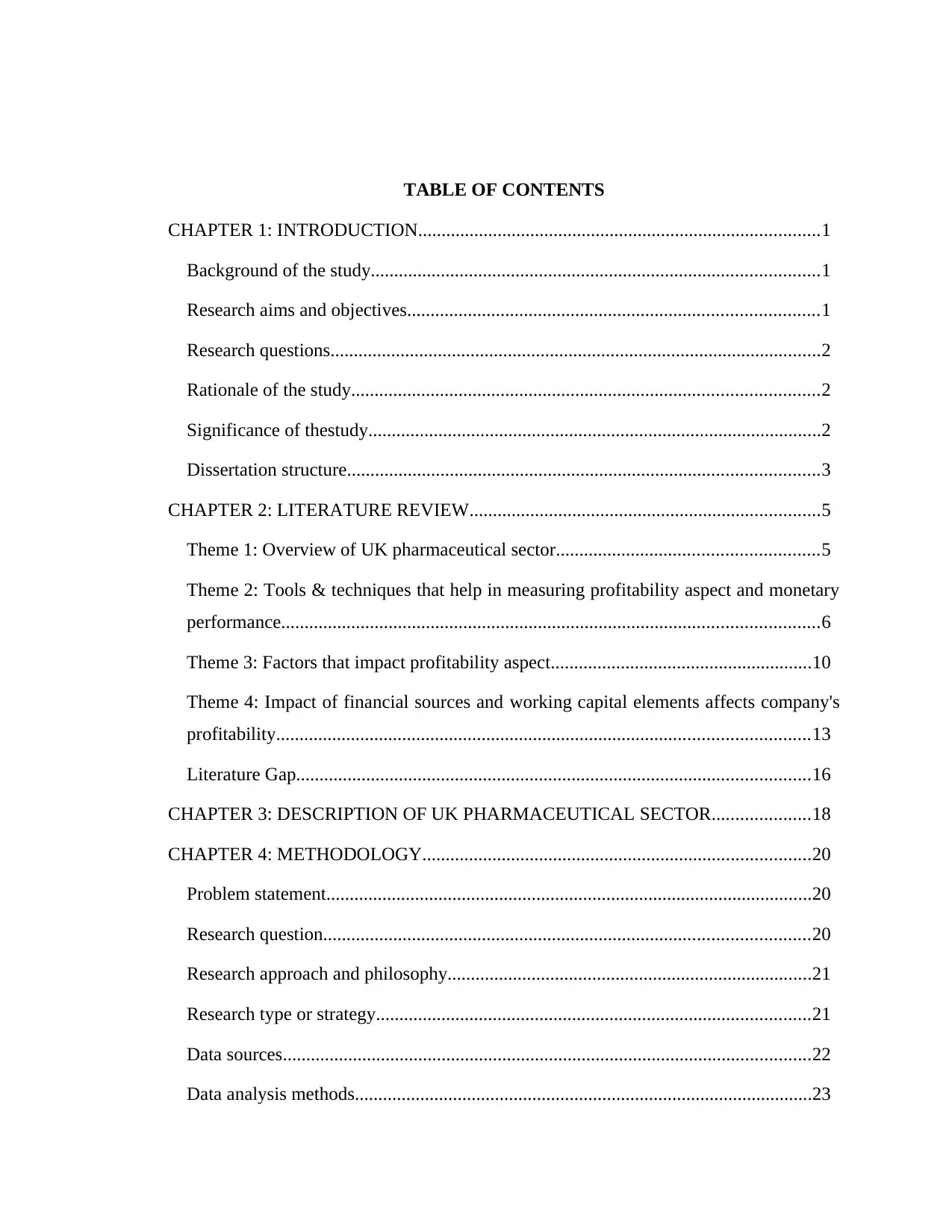
TABLE OF CONTENTS
CHAPTER 1: INTRODUCTION......................................................................................1
Background of the study................................................................................................1
Research aims and objectives........................................................................................1
Research questions.........................................................................................................2
Rationale of the study....................................................................................................2
Significance of thestudy.................................................................................................2
Dissertation structure.....................................................................................................3
CHAPTER 2: LITERATURE REVIEW...........................................................................5
Theme 1: Overview of UK pharmaceutical sector........................................................5
Theme 2: Tools & techniques that help in measuring profitability aspect and monetary
performance...................................................................................................................6
Theme 3: Factors that impact profitability aspect........................................................10
Theme 4: Impact of financial sources and working capital elements affects company's
profitability..................................................................................................................13
Literature Gap..............................................................................................................16
CHAPTER 3: DESCRIPTION OF UK PHARMACEUTICAL SECTOR.....................18
CHAPTER 4: METHODOLOGY...................................................................................20
Problem statement........................................................................................................20
Research question........................................................................................................20
Research approach and philosophy..............................................................................21
Research type or strategy.............................................................................................21
Data sources.................................................................................................................22
Data analysis methods..................................................................................................23
CHAPTER 1: INTRODUCTION......................................................................................1
Background of the study................................................................................................1
Research aims and objectives........................................................................................1
Research questions.........................................................................................................2
Rationale of the study....................................................................................................2
Significance of thestudy.................................................................................................2
Dissertation structure.....................................................................................................3
CHAPTER 2: LITERATURE REVIEW...........................................................................5
Theme 1: Overview of UK pharmaceutical sector........................................................5
Theme 2: Tools & techniques that help in measuring profitability aspect and monetary
performance...................................................................................................................6
Theme 3: Factors that impact profitability aspect........................................................10
Theme 4: Impact of financial sources and working capital elements affects company's
profitability..................................................................................................................13
Literature Gap..............................................................................................................16
CHAPTER 3: DESCRIPTION OF UK PHARMACEUTICAL SECTOR.....................18
CHAPTER 4: METHODOLOGY...................................................................................20
Problem statement........................................................................................................20
Research question........................................................................................................20
Research approach and philosophy..............................................................................21
Research type or strategy.............................................................................................21
Data sources.................................................................................................................22
Data analysis methods..................................................................................................23
Paraphrase This Document
Need a fresh take? Get an instant paraphrase of this document with our AI Paraphraser
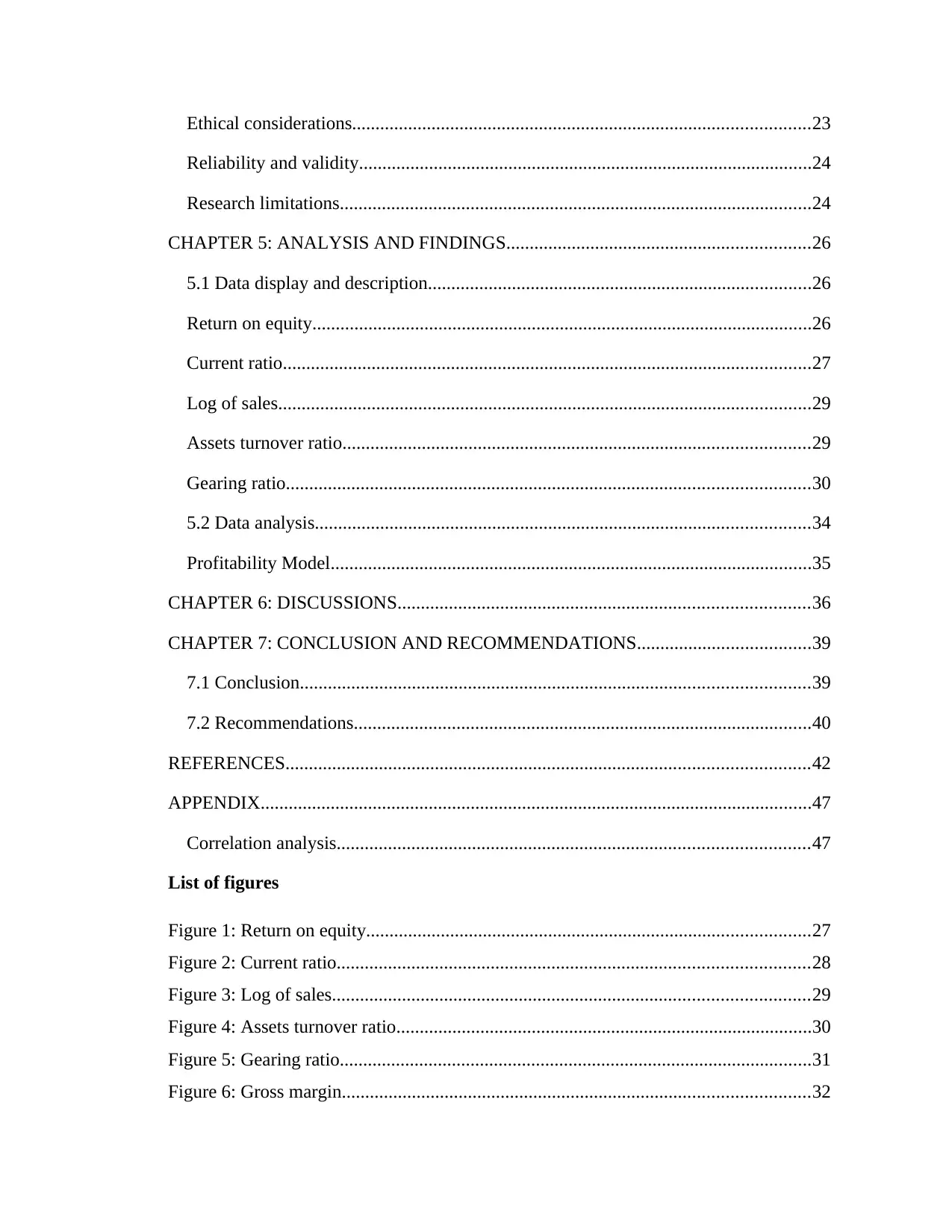
Ethical considerations..................................................................................................23
Reliability and validity.................................................................................................24
Research limitations.....................................................................................................24
CHAPTER 5: ANALYSIS AND FINDINGS.................................................................26
5.1 Data display and description..................................................................................26
Return on equity...........................................................................................................26
Current ratio.................................................................................................................27
Log of sales..................................................................................................................29
Assets turnover ratio....................................................................................................29
Gearing ratio................................................................................................................30
5.2 Data analysis..........................................................................................................34
Profitability Model.......................................................................................................35
CHAPTER 6: DISCUSSIONS........................................................................................36
CHAPTER 7: CONCLUSION AND RECOMMENDATIONS.....................................39
7.1 Conclusion.............................................................................................................39
7.2 Recommendations..................................................................................................40
REFERENCES................................................................................................................42
APPENDIX......................................................................................................................47
Correlation analysis.....................................................................................................47
List of figures
Figure 1: Return on equity...............................................................................................27
Figure 2: Current ratio.....................................................................................................28
Figure 3: Log of sales......................................................................................................29
Figure 4: Assets turnover ratio.........................................................................................30
Figure 5: Gearing ratio.....................................................................................................31
Figure 6: Gross margin....................................................................................................32
Reliability and validity.................................................................................................24
Research limitations.....................................................................................................24
CHAPTER 5: ANALYSIS AND FINDINGS.................................................................26
5.1 Data display and description..................................................................................26
Return on equity...........................................................................................................26
Current ratio.................................................................................................................27
Log of sales..................................................................................................................29
Assets turnover ratio....................................................................................................29
Gearing ratio................................................................................................................30
5.2 Data analysis..........................................................................................................34
Profitability Model.......................................................................................................35
CHAPTER 6: DISCUSSIONS........................................................................................36
CHAPTER 7: CONCLUSION AND RECOMMENDATIONS.....................................39
7.1 Conclusion.............................................................................................................39
7.2 Recommendations..................................................................................................40
REFERENCES................................................................................................................42
APPENDIX......................................................................................................................47
Correlation analysis.....................................................................................................47
List of figures
Figure 1: Return on equity...............................................................................................27
Figure 2: Current ratio.....................................................................................................28
Figure 3: Log of sales......................................................................................................29
Figure 4: Assets turnover ratio.........................................................................................30
Figure 5: Gearing ratio.....................................................................................................31
Figure 6: Gross margin....................................................................................................32

Figure 7: Efficiency ratio.................................................................................................33
⊘ This is a preview!⊘
Do you want full access?
Subscribe today to unlock all pages.

Trusted by 1+ million students worldwide
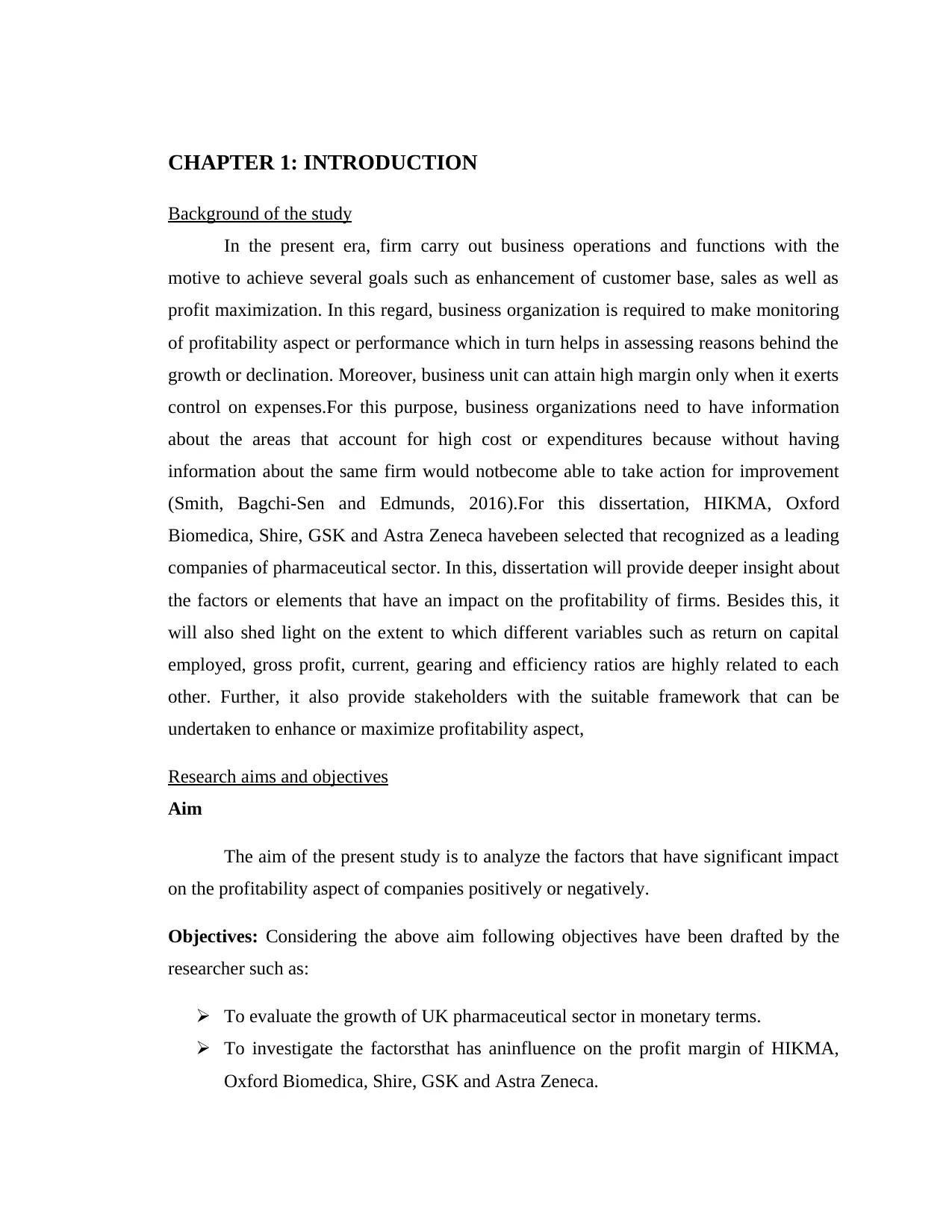
CHAPTER 1: INTRODUCTION
Background of the study
In the present era, firm carry out business operations and functions with the
motive to achieve several goals such as enhancement of customer base, sales as well as
profit maximization. In this regard, business organization is required to make monitoring
of profitability aspect or performance which in turn helps in assessing reasons behind the
growth or declination. Moreover, business unit can attain high margin only when it exerts
control on expenses.For this purpose, business organizations need to have information
about the areas that account for high cost or expenditures because without having
information about the same firm would notbecome able to take action for improvement
(Smith, Bagchi-Sen and Edmunds, 2016).For this dissertation, HIKMA, Oxford
Biomedica, Shire, GSK and Astra Zeneca havebeen selected that recognized as a leading
companies of pharmaceutical sector. In this, dissertation will provide deeper insight about
the factors or elements that have an impact on the profitability of firms. Besides this, it
will also shed light on the extent to which different variables such as return on capital
employed, gross profit, current, gearing and efficiency ratios are highly related to each
other. Further, it also provide stakeholders with the suitable framework that can be
undertaken to enhance or maximize profitability aspect,
Research aims and objectives
Aim
The aim of the present study is to analyze the factors that have significant impact
on the profitability aspect of companies positively or negatively.
Objectives: Considering the above aim following objectives have been drafted by the
researcher such as:
To evaluate the growth of UK pharmaceutical sector in monetary terms.
To investigate the factorsthat has aninfluence on the profit margin of HIKMA,
Oxford Biomedica, Shire, GSK and Astra Zeneca.
Background of the study
In the present era, firm carry out business operations and functions with the
motive to achieve several goals such as enhancement of customer base, sales as well as
profit maximization. In this regard, business organization is required to make monitoring
of profitability aspect or performance which in turn helps in assessing reasons behind the
growth or declination. Moreover, business unit can attain high margin only when it exerts
control on expenses.For this purpose, business organizations need to have information
about the areas that account for high cost or expenditures because without having
information about the same firm would notbecome able to take action for improvement
(Smith, Bagchi-Sen and Edmunds, 2016).For this dissertation, HIKMA, Oxford
Biomedica, Shire, GSK and Astra Zeneca havebeen selected that recognized as a leading
companies of pharmaceutical sector. In this, dissertation will provide deeper insight about
the factors or elements that have an impact on the profitability of firms. Besides this, it
will also shed light on the extent to which different variables such as return on capital
employed, gross profit, current, gearing and efficiency ratios are highly related to each
other. Further, it also provide stakeholders with the suitable framework that can be
undertaken to enhance or maximize profitability aspect,
Research aims and objectives
Aim
The aim of the present study is to analyze the factors that have significant impact
on the profitability aspect of companies positively or negatively.
Objectives: Considering the above aim following objectives have been drafted by the
researcher such as:
To evaluate the growth of UK pharmaceutical sector in monetary terms.
To investigate the factorsthat has aninfluence on the profit margin of HIKMA,
Oxford Biomedica, Shire, GSK and Astra Zeneca.
Paraphrase This Document
Need a fresh take? Get an instant paraphrase of this document with our AI Paraphraser
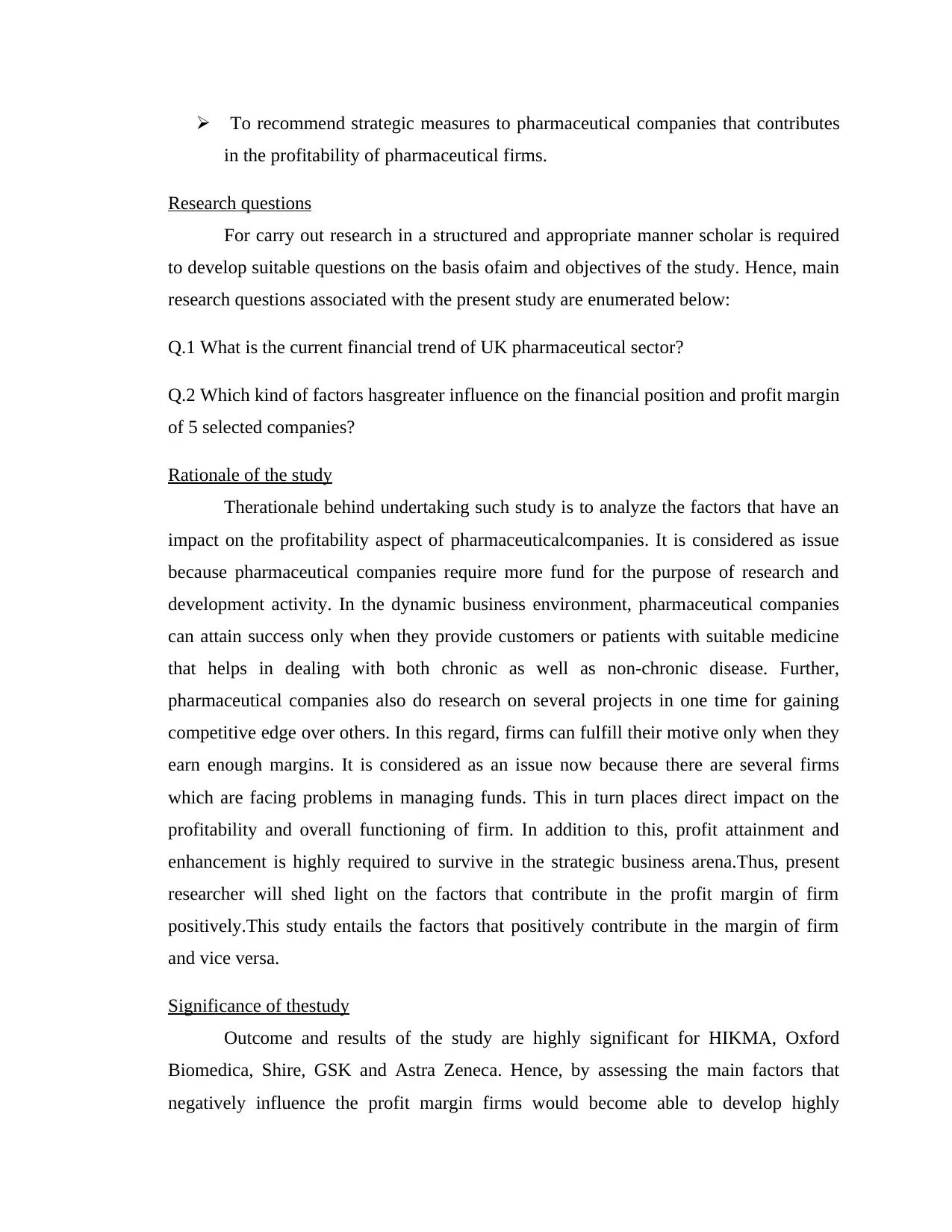
To recommend strategic measures to pharmaceutical companies that contributes
in the profitability of pharmaceutical firms.
Research questions
For carry out research in a structured and appropriate manner scholar is required
to develop suitable questions on the basis ofaim and objectives of the study. Hence, main
research questions associated with the present study are enumerated below:
Q.1 What is the current financial trend of UK pharmaceutical sector?
Q.2 Which kind of factors hasgreater influence on the financial position and profit margin
of 5 selected companies?
Rationale of the study
Therationale behind undertaking such study is to analyze the factors that have an
impact on the profitability aspect of pharmaceuticalcompanies. It is considered as issue
because pharmaceutical companies require more fund for the purpose of research and
development activity. In the dynamic business environment, pharmaceutical companies
can attain success only when they provide customers or patients with suitable medicine
that helps in dealing with both chronic as well as non-chronic disease. Further,
pharmaceutical companies also do research on several projects in one time for gaining
competitive edge over others. In this regard, firms can fulfill their motive only when they
earn enough margins. It is considered as an issue now because there are several firms
which are facing problems in managing funds. This in turn places direct impact on the
profitability and overall functioning of firm. In addition to this, profit attainment and
enhancement is highly required to survive in the strategic business arena.Thus, present
researcher will shed light on the factors that contribute in the profit margin of firm
positively.This study entails the factors that positively contribute in the margin of firm
and vice versa.
Significance of thestudy
Outcome and results of the study are highly significant for HIKMA, Oxford
Biomedica, Shire, GSK and Astra Zeneca. Hence, by assessing the main factors that
negatively influence the profit margin firms would become able to develop highly
in the profitability of pharmaceutical firms.
Research questions
For carry out research in a structured and appropriate manner scholar is required
to develop suitable questions on the basis ofaim and objectives of the study. Hence, main
research questions associated with the present study are enumerated below:
Q.1 What is the current financial trend of UK pharmaceutical sector?
Q.2 Which kind of factors hasgreater influence on the financial position and profit margin
of 5 selected companies?
Rationale of the study
Therationale behind undertaking such study is to analyze the factors that have an
impact on the profitability aspect of pharmaceuticalcompanies. It is considered as issue
because pharmaceutical companies require more fund for the purpose of research and
development activity. In the dynamic business environment, pharmaceutical companies
can attain success only when they provide customers or patients with suitable medicine
that helps in dealing with both chronic as well as non-chronic disease. Further,
pharmaceutical companies also do research on several projects in one time for gaining
competitive edge over others. In this regard, firms can fulfill their motive only when they
earn enough margins. It is considered as an issue now because there are several firms
which are facing problems in managing funds. This in turn places direct impact on the
profitability and overall functioning of firm. In addition to this, profit attainment and
enhancement is highly required to survive in the strategic business arena.Thus, present
researcher will shed light on the factors that contribute in the profit margin of firm
positively.This study entails the factors that positively contribute in the margin of firm
and vice versa.
Significance of thestudy
Outcome and results of the study are highly significant for HIKMA, Oxford
Biomedica, Shire, GSK and Astra Zeneca. Hence, by assessing the main factors that
negatively influence the profit margin firms would become able to develop highly
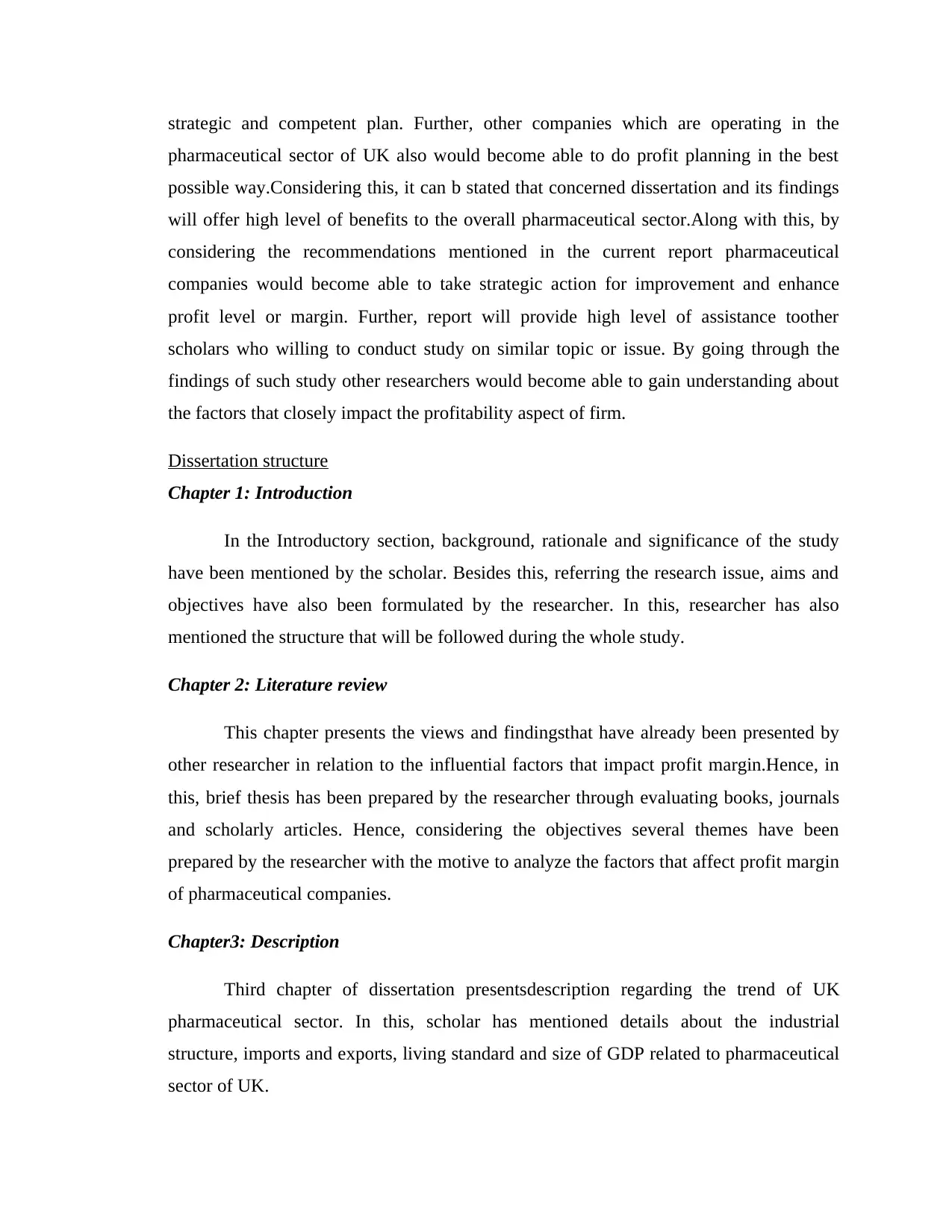
strategic and competent plan. Further, other companies which are operating in the
pharmaceutical sector of UK also would become able to do profit planning in the best
possible way.Considering this, it can b stated that concerned dissertation and its findings
will offer high level of benefits to the overall pharmaceutical sector.Along with this, by
considering the recommendations mentioned in the current report pharmaceutical
companies would become able to take strategic action for improvement and enhance
profit level or margin. Further, report will provide high level of assistance toother
scholars who willing to conduct study on similar topic or issue. By going through the
findings of such study other researchers would become able to gain understanding about
the factors that closely impact the profitability aspect of firm.
Dissertation structure
Chapter 1: Introduction
In the Introductory section, background, rationale and significance of the study
have been mentioned by the scholar. Besides this, referring the research issue, aims and
objectives have also been formulated by the researcher. In this, researcher has also
mentioned the structure that will be followed during the whole study.
Chapter 2: Literature review
This chapter presents the views and findingsthat have already been presented by
other researcher in relation to the influential factors that impact profit margin.Hence, in
this, brief thesis has been prepared by the researcher through evaluating books, journals
and scholarly articles. Hence, considering the objectives several themes have been
prepared by the researcher with the motive to analyze the factors that affect profit margin
of pharmaceutical companies.
Chapter3: Description
Third chapter of dissertation presentsdescription regarding the trend of UK
pharmaceutical sector. In this, scholar has mentioned details about the industrial
structure, imports and exports, living standard and size of GDP related to pharmaceutical
sector of UK.
pharmaceutical sector of UK also would become able to do profit planning in the best
possible way.Considering this, it can b stated that concerned dissertation and its findings
will offer high level of benefits to the overall pharmaceutical sector.Along with this, by
considering the recommendations mentioned in the current report pharmaceutical
companies would become able to take strategic action for improvement and enhance
profit level or margin. Further, report will provide high level of assistance toother
scholars who willing to conduct study on similar topic or issue. By going through the
findings of such study other researchers would become able to gain understanding about
the factors that closely impact the profitability aspect of firm.
Dissertation structure
Chapter 1: Introduction
In the Introductory section, background, rationale and significance of the study
have been mentioned by the scholar. Besides this, referring the research issue, aims and
objectives have also been formulated by the researcher. In this, researcher has also
mentioned the structure that will be followed during the whole study.
Chapter 2: Literature review
This chapter presents the views and findingsthat have already been presented by
other researcher in relation to the influential factors that impact profit margin.Hence, in
this, brief thesis has been prepared by the researcher through evaluating books, journals
and scholarly articles. Hence, considering the objectives several themes have been
prepared by the researcher with the motive to analyze the factors that affect profit margin
of pharmaceutical companies.
Chapter3: Description
Third chapter of dissertation presentsdescription regarding the trend of UK
pharmaceutical sector. In this, scholar has mentioned details about the industrial
structure, imports and exports, living standard and size of GDP related to pharmaceutical
sector of UK.
⊘ This is a preview!⊘
Do you want full access?
Subscribe today to unlock all pages.

Trusted by 1+ million students worldwide
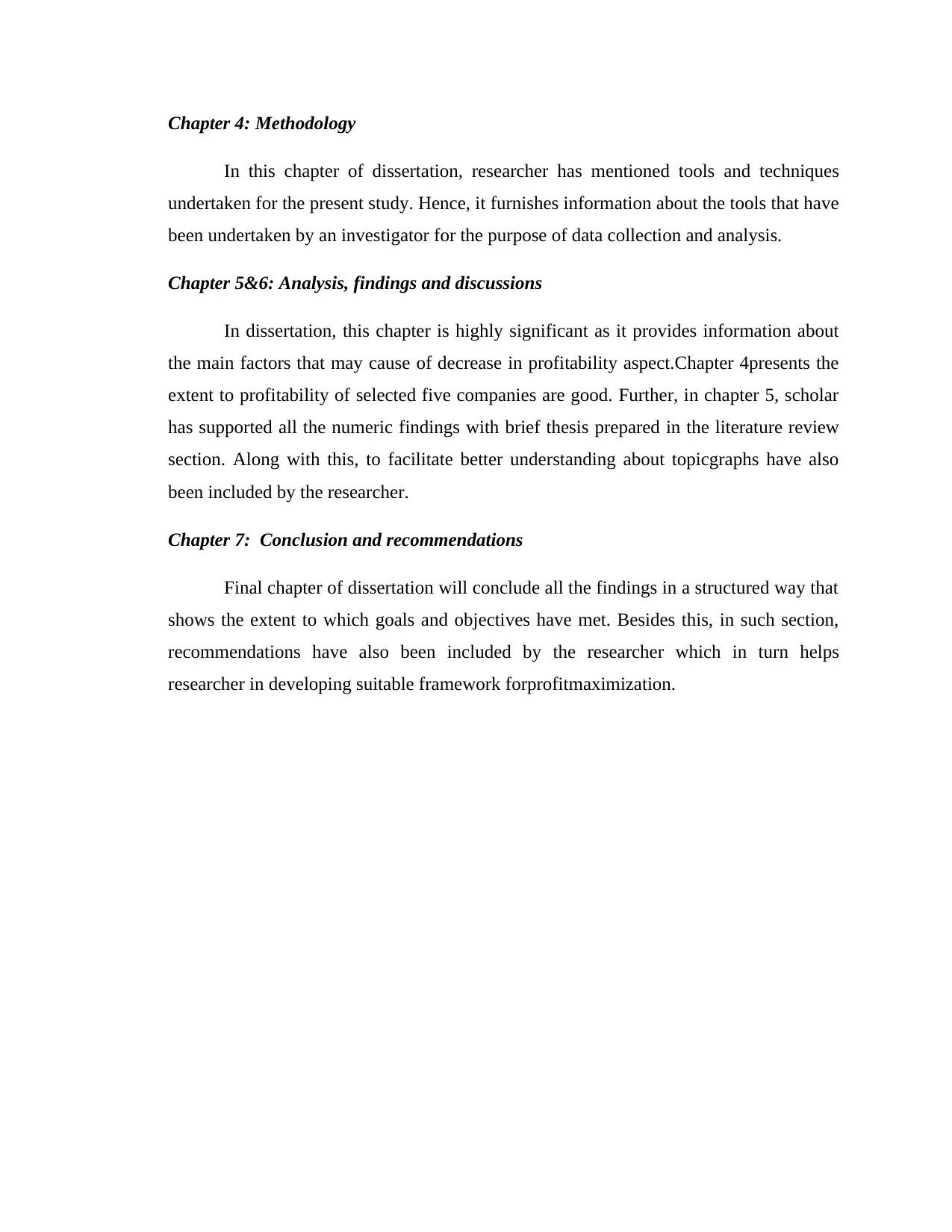
Chapter 4: Methodology
In this chapter of dissertation, researcher has mentioned tools and techniques
undertaken for the present study. Hence, it furnishes information about the tools that have
been undertaken by an investigator for the purpose of data collection and analysis.
Chapter 5&6: Analysis, findings and discussions
In dissertation, this chapter is highly significant as it provides information about
the main factors that may cause of decrease in profitability aspect.Chapter 4presents the
extent to profitability of selected five companies are good. Further, in chapter 5, scholar
has supported all the numeric findings with brief thesis prepared in the literature review
section. Along with this, to facilitate better understanding about topicgraphs have also
been included by the researcher.
Chapter 7: Conclusion and recommendations
Final chapter of dissertation will conclude all the findings in a structured way that
shows the extent to which goals and objectives have met. Besides this, in such section,
recommendations have also been included by the researcher which in turn helps
researcher in developing suitable framework forprofitmaximization.
In this chapter of dissertation, researcher has mentioned tools and techniques
undertaken for the present study. Hence, it furnishes information about the tools that have
been undertaken by an investigator for the purpose of data collection and analysis.
Chapter 5&6: Analysis, findings and discussions
In dissertation, this chapter is highly significant as it provides information about
the main factors that may cause of decrease in profitability aspect.Chapter 4presents the
extent to profitability of selected five companies are good. Further, in chapter 5, scholar
has supported all the numeric findings with brief thesis prepared in the literature review
section. Along with this, to facilitate better understanding about topicgraphs have also
been included by the researcher.
Chapter 7: Conclusion and recommendations
Final chapter of dissertation will conclude all the findings in a structured way that
shows the extent to which goals and objectives have met. Besides this, in such section,
recommendations have also been included by the researcher which in turn helps
researcher in developing suitable framework forprofitmaximization.
Paraphrase This Document
Need a fresh take? Get an instant paraphrase of this document with our AI Paraphraser
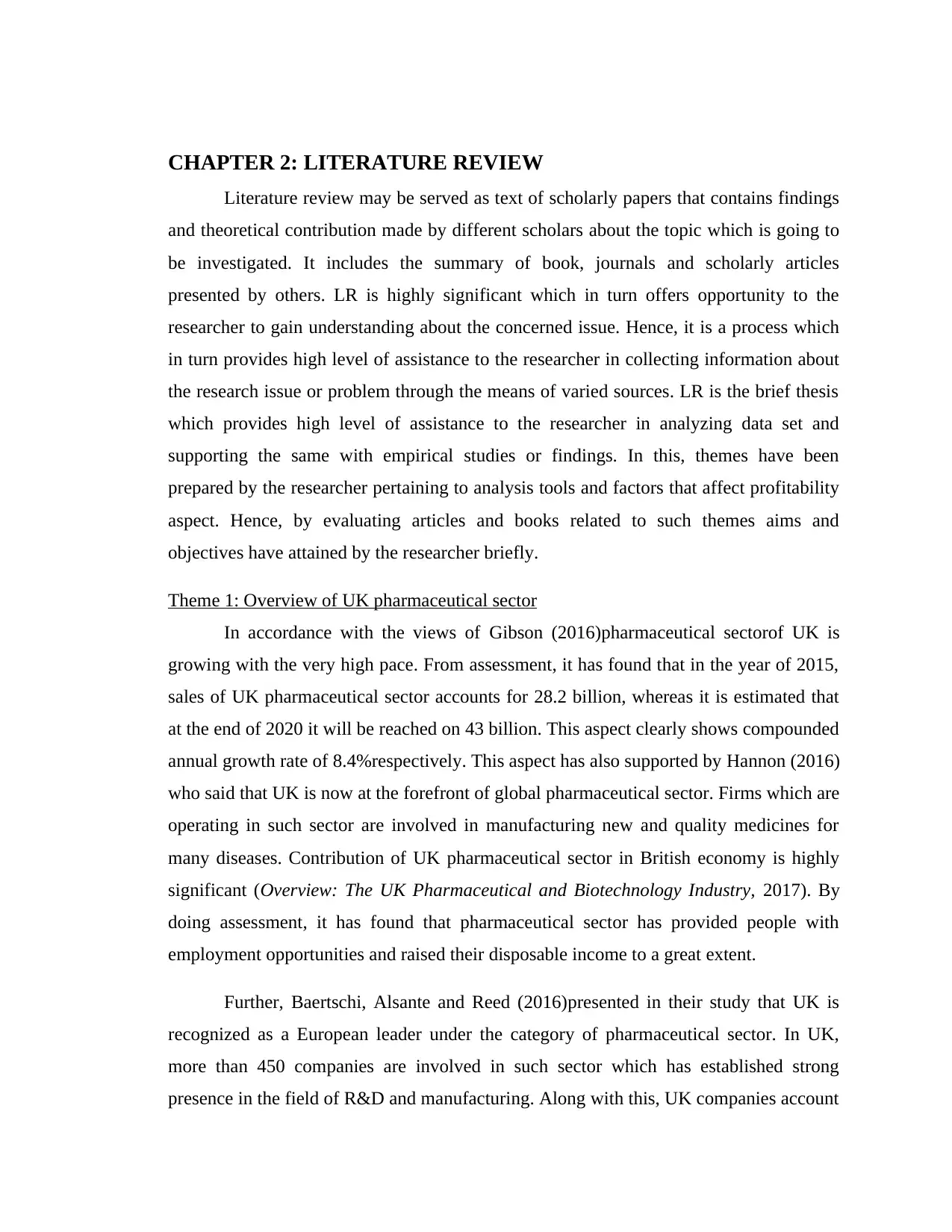
CHAPTER 2: LITERATURE REVIEW
Literature review may be served as text of scholarly papers that contains findings
and theoretical contribution made by different scholars about the topic which is going to
be investigated. It includes the summary of book, journals and scholarly articles
presented by others. LR is highly significant which in turn offers opportunity to the
researcher to gain understanding about the concerned issue. Hence, it is a process which
in turn provides high level of assistance to the researcher in collecting information about
the research issue or problem through the means of varied sources. LR is the brief thesis
which provides high level of assistance to the researcher in analyzing data set and
supporting the same with empirical studies or findings. In this, themes have been
prepared by the researcher pertaining to analysis tools and factors that affect profitability
aspect. Hence, by evaluating articles and books related to such themes aims and
objectives have attained by the researcher briefly.
Theme 1: Overview of UK pharmaceutical sector
In accordance with the views of Gibson (2016)pharmaceutical sectorof UK is
growing with the very high pace. From assessment, it has found that in the year of 2015,
sales of UK pharmaceutical sector accounts for 28.2 billion, whereas it is estimated that
at the end of 2020 it will be reached on 43 billion. This aspect clearly shows compounded
annual growth rate of 8.4%respectively. This aspect has also supported by Hannon (2016)
who said that UK is now at the forefront of global pharmaceutical sector. Firms which are
operating in such sector are involved in manufacturing new and quality medicines for
many diseases. Contribution of UK pharmaceutical sector in British economy is highly
significant (Overview: The UK Pharmaceutical and Biotechnology Industry, 2017). By
doing assessment, it has found that pharmaceutical sector has provided people with
employment opportunities and raised their disposable income to a great extent.
Further, Baertschi, Alsante and Reed (2016)presented in their study that UK is
recognized as a European leader under the category of pharmaceutical sector. In UK,
more than 450 companies are involved in such sector which has established strong
presence in the field of R&D and manufacturing. Along with this, UK companies account
Literature review may be served as text of scholarly papers that contains findings
and theoretical contribution made by different scholars about the topic which is going to
be investigated. It includes the summary of book, journals and scholarly articles
presented by others. LR is highly significant which in turn offers opportunity to the
researcher to gain understanding about the concerned issue. Hence, it is a process which
in turn provides high level of assistance to the researcher in collecting information about
the research issue or problem through the means of varied sources. LR is the brief thesis
which provides high level of assistance to the researcher in analyzing data set and
supporting the same with empirical studies or findings. In this, themes have been
prepared by the researcher pertaining to analysis tools and factors that affect profitability
aspect. Hence, by evaluating articles and books related to such themes aims and
objectives have attained by the researcher briefly.
Theme 1: Overview of UK pharmaceutical sector
In accordance with the views of Gibson (2016)pharmaceutical sectorof UK is
growing with the very high pace. From assessment, it has found that in the year of 2015,
sales of UK pharmaceutical sector accounts for 28.2 billion, whereas it is estimated that
at the end of 2020 it will be reached on 43 billion. This aspect clearly shows compounded
annual growth rate of 8.4%respectively. This aspect has also supported by Hannon (2016)
who said that UK is now at the forefront of global pharmaceutical sector. Firms which are
operating in such sector are involved in manufacturing new and quality medicines for
many diseases. Contribution of UK pharmaceutical sector in British economy is highly
significant (Overview: The UK Pharmaceutical and Biotechnology Industry, 2017). By
doing assessment, it has found that pharmaceutical sector has provided people with
employment opportunities and raised their disposable income to a great extent.
Further, Baertschi, Alsante and Reed (2016)presented in their study that UK is
recognized as a European leader under the category of pharmaceutical sector. In UK,
more than 450 companies are involved in such sector which has established strong
presence in the field of R&D and manufacturing. Along with this, UK companies account
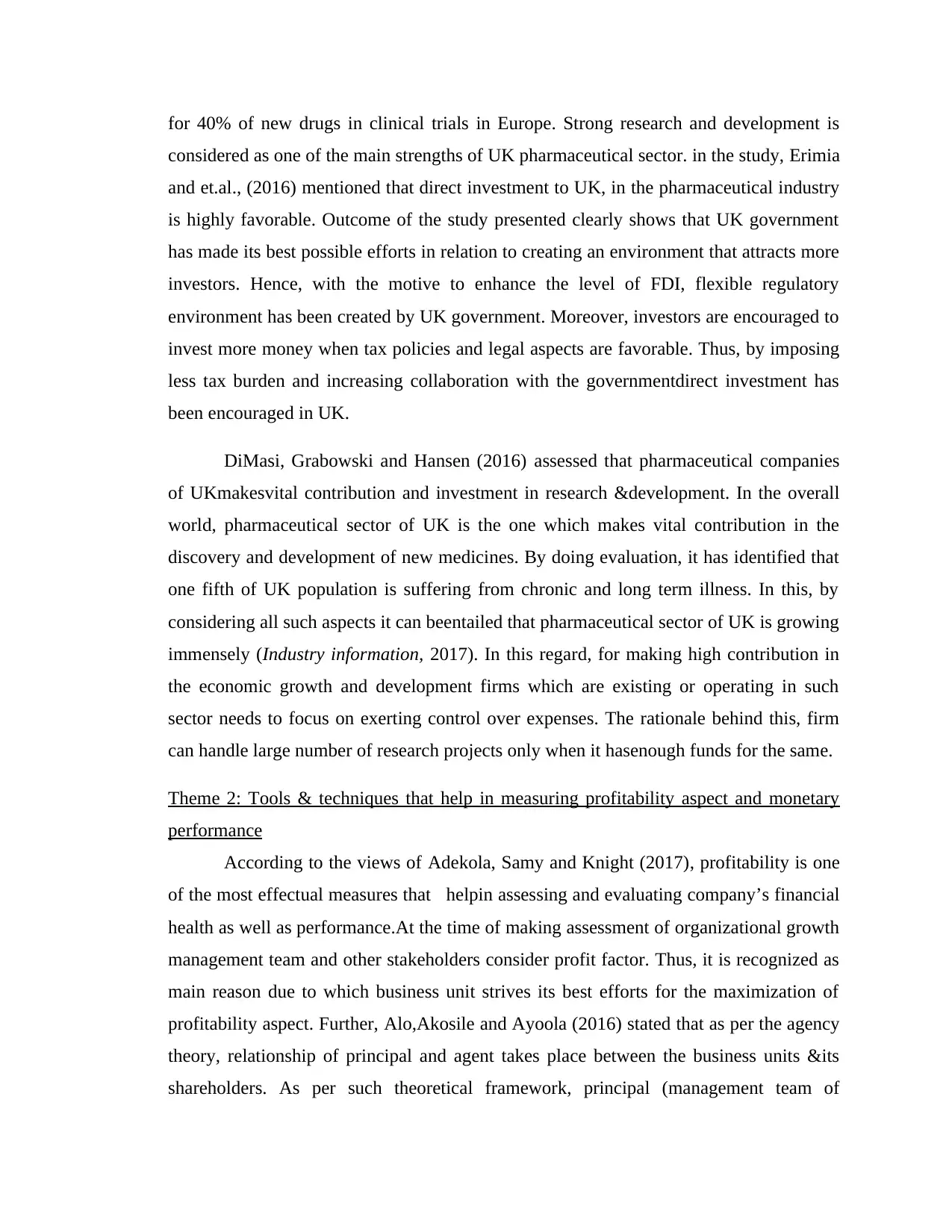
for 40% of new drugs in clinical trials in Europe. Strong research and development is
considered as one of the main strengths of UK pharmaceutical sector. in the study, Erimia
and et.al., (2016) mentioned that direct investment to UK, in the pharmaceutical industry
is highly favorable. Outcome of the study presented clearly shows that UK government
has made its best possible efforts in relation to creating an environment that attracts more
investors. Hence, with the motive to enhance the level of FDI, flexible regulatory
environment has been created by UK government. Moreover, investors are encouraged to
invest more money when tax policies and legal aspects are favorable. Thus, by imposing
less tax burden and increasing collaboration with the governmentdirect investment has
been encouraged in UK.
DiMasi, Grabowski and Hansen (2016) assessed that pharmaceutical companies
of UKmakesvital contribution and investment in research &development. In the overall
world, pharmaceutical sector of UK is the one which makes vital contribution in the
discovery and development of new medicines. By doing evaluation, it has identified that
one fifth of UK population is suffering from chronic and long term illness. In this, by
considering all such aspects it can beentailed that pharmaceutical sector of UK is growing
immensely (Industry information, 2017). In this regard, for making high contribution in
the economic growth and development firms which are existing or operating in such
sector needs to focus on exerting control over expenses. The rationale behind this, firm
can handle large number of research projects only when it hasenough funds for the same.
Theme 2: Tools & techniques that help in measuring profitability aspect and monetary
performance
According to the views of Adekola, Samy and Knight (2017), profitability is one
of the most effectual measures that helpin assessing and evaluating company’s financial
health as well as performance.At the time of making assessment of organizational growth
management team and other stakeholders consider profit factor. Thus, it is recognized as
main reason due to which business unit strives its best efforts for the maximization of
profitability aspect. Further, Alo,Akosile and Ayoola (2016) stated that as per the agency
theory, relationship of principal and agent takes place between the business units &its
shareholders. As per such theoretical framework, principal (management team of
considered as one of the main strengths of UK pharmaceutical sector. in the study, Erimia
and et.al., (2016) mentioned that direct investment to UK, in the pharmaceutical industry
is highly favorable. Outcome of the study presented clearly shows that UK government
has made its best possible efforts in relation to creating an environment that attracts more
investors. Hence, with the motive to enhance the level of FDI, flexible regulatory
environment has been created by UK government. Moreover, investors are encouraged to
invest more money when tax policies and legal aspects are favorable. Thus, by imposing
less tax burden and increasing collaboration with the governmentdirect investment has
been encouraged in UK.
DiMasi, Grabowski and Hansen (2016) assessed that pharmaceutical companies
of UKmakesvital contribution and investment in research &development. In the overall
world, pharmaceutical sector of UK is the one which makes vital contribution in the
discovery and development of new medicines. By doing evaluation, it has identified that
one fifth of UK population is suffering from chronic and long term illness. In this, by
considering all such aspects it can beentailed that pharmaceutical sector of UK is growing
immensely (Industry information, 2017). In this regard, for making high contribution in
the economic growth and development firms which are existing or operating in such
sector needs to focus on exerting control over expenses. The rationale behind this, firm
can handle large number of research projects only when it hasenough funds for the same.
Theme 2: Tools & techniques that help in measuring profitability aspect and monetary
performance
According to the views of Adekola, Samy and Knight (2017), profitability is one
of the most effectual measures that helpin assessing and evaluating company’s financial
health as well as performance.At the time of making assessment of organizational growth
management team and other stakeholders consider profit factor. Thus, it is recognized as
main reason due to which business unit strives its best efforts for the maximization of
profitability aspect. Further, Alo,Akosile and Ayoola (2016) stated that as per the agency
theory, relationship of principal and agent takes place between the business units &its
shareholders. As per such theoretical framework, principal (management team of
⊘ This is a preview!⊘
Do you want full access?
Subscribe today to unlock all pages.

Trusted by 1+ million students worldwide
1 out of 56
Related Documents
Your All-in-One AI-Powered Toolkit for Academic Success.
+13062052269
info@desklib.com
Available 24*7 on WhatsApp / Email
![[object Object]](/_next/static/media/star-bottom.7253800d.svg)
Unlock your academic potential
Copyright © 2020–2025 A2Z Services. All Rights Reserved. Developed and managed by ZUCOL.





